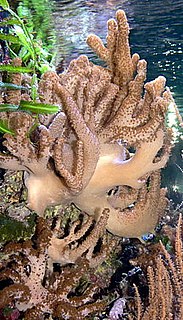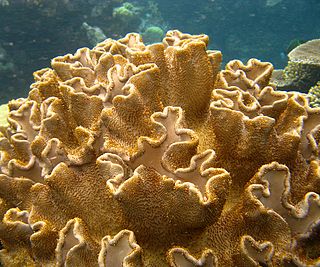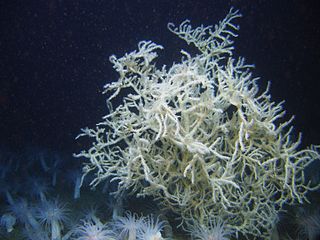
Corals are marine invertebrates within the class Anthozoa of the phylum Cnidaria. They typically form compact colonies of many identical individual polyps. Coral species include the important reef builders that inhabit tropical oceans and secrete calcium carbonate to form a hard skeleton.

The organ pipe coral is an alcyonarian octocoral native to the waters of the Indian Ocean and the central and western regions of the Pacific Ocean. It is the only known species of the genus Tubipora. This species is a soft coral but with a unique, hard skeleton of calcium carbonate that contains many organ pipe-like tubes. On each tube is a series of polyps which each have eight feather-like tentacles. These tentacles are usually extended during the day, but will swiftly withdraw with any sort of disturbance. The skeleton is a bright red color, but is typically obscured by numerous polyps. Because of this, living colonies are typically green, blue, or purple due to the color of the expanded polyps. Colonies are typically dome-shaped and can reach up to 3 meters across, while the individual polyps are typically less than 3 mm wide and a few mm long. They are close relatives to other soft coral and sea fans. This species is a popular aquarium coral due to its ease to maintain, as well as higher tolerance compared to most true corals. However, its popularity presents a problem: along with its potential as an aquarium coral, the species' coloration makes it a popular commodity for tourists, leading to a variety of threats to the population.

Alcyonacea, or soft corals, are an order of corals. In addition to the fleshy soft corals, the order Alcyonacea now contains all species previously known as "gorgonian corals", that produce a more or less hard skeleton, though quite different from "true" corals (Scleractinia). These can be found in suborders Holaxonia, Scleraxonia, and Stolonifera. They are sessile colonial cnidarians that are found throughout the oceans of the world, especially in the deep sea, polar waters, tropics and subtropics. Common names for subsets of this order are sea fans and sea whips; others are similar to the sea pens of related order Pennatulacea. Individual tiny polyps form colonies that are normally erect, flattened, branching, and reminiscent of a fan. Others may be whiplike, bushy, or even encrusting. A colony can be several feet high and across, but only a few inches thick. They may be brightly coloured, often purple, red, or yellow. Photosynthetic gorgonians can be successfully kept in captive aquaria.

Precious coral, or red coral, is the common name given to a genus of marine corals, Corallium. The distinguishing characteristic of precious corals is their durable and intensely colored red or pink-orange skeleton, which is used for making jewelry.

The pulsating xenid is a species of soft coral in the family Xeniidae.

Alcyoniidae is a family of leathery or soft corals in the phylum Cnidaria.

The multicoloured sea fan is a species of gorgonian sea fan in the family Melithaeidae.

Montipora digitata, also known as finger coral, is a species of stony coral. It is found in shallow water in East Africa, the Indo-West Pacific, Kenya, Mozambique and Rodriguez.

Leptogorgia virgulata, commonly known as the sea whip or colorful sea whip, is a species of soft coral in the family Gorgoniidae.

Gersemia rubiformis, commonly known as the sea strawberry, is a species of soft coral in the family Nephtheidae. It is found in the northwest Atlantic and the northeast Pacific Oceans.

Melithaea ochracea is a species of colonial soft coral in the family Melithaeidae, commonly known as knotted fan coral. It grows in tree-like fans on coral reefs in the South China Sea. It is used in the jewellery industry under the name red spongy coral.

The purple soft coral is a species of colonial soft coral in the family Alcyoniidae.
The Valdivian soft coral is a species of colonial leathery or soft coral in the family Alcyoniidae.

The sun-burst soft coral is a species of colonial soft corals in the family Alcyoniidae. It is the only species known in the genus Malacacanthus.

The cauliflower soft coral is a species of colonial soft coral in the family Nephtheidae.

Stylaster nobilis, the noble coral, is a branching colonial hydroid in the family Stylasteridae.

Leptogorgia sarmentosa is a species of colonial soft coral, a sea fan in the family Gorgoniidae. It is native to the eastern Atlantic Ocean and the western Mediterranean Sea, with a single find in the eastern Mediterranean.

Leiopathes glaberrima is a species of black coral of the order Antipatharia found in the northern Atlantic Ocean and the Mediterranean Seas deep water habitats. A very slow-growing species, it is among the oldest living animals on the planet.

Gersemia juliepackardae is a species of soft coral in the family Nephtheidae. It is found in the northeast Pacific Ocean, on seamounts or on the deep ocean bed. The coral is named in honour of Julie Packard, the executive director of the Monterey Bay Aquarium, for "her dedication to ocean stewardship and conservation, and for elevating public awareness about the ocean environment."



















